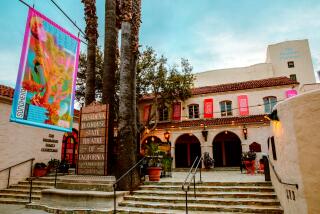L.A. Phil, Pasadena Playhouse get big grants to reach new audiences
- Share via
The Los Angeles Philharmonic, Pasadena Playhouse and La Jolla Playhouse will get a collective boost of $1,425,000 for their efforts to mint new fans in the coming two years, and they’ve qualified for a second round of grants to carry the effort into 2019.
The three Southern California groups are among 26 nonprofit performing arts organizations nationwide tapped by the New York City-based Wallace Foundation, which plans to spend $52 million over six years in hopes of turning more Americans into arts aficionados.
The program is designed to be a sort of laboratory for the performing arts, in which each group will develop its own strategy for reaching a specific audience it has chosen as its target. That might include people under 40, a racial or ethnic group, people living in a particular neighborhood, young professionals or some other demographic.
The grants announced Wednesday total $10.2 million. They cover a 12- to 22-month “cycle” in which each recipient will conduct research needed to solidify a plan that might involve different kinds of performances, taking shows to different kinds of venues, using different marketing approaches and providing educational add-ons to help audiences connect more deeply with what they’re seeing.
After the first cycle is complete, the 26 groups, which include orchestras and opera, theater and dance companies, will assess accomplishments and apply for a second round of grants intended to further grow or reinforce connections with whatever group they’ve targeted.
A foundation spokeswoman said that about 80% of the $52 million will go directly to the 26 organizations. The rest will cover related expenses such as research and technical assistance to the groups, as well as $3.5 million that Wallace plans to spend after the two grant cycles are over to analyze the program’s results and publish them in a series of reports, so that other organizations can copy the successes and learn from the mistakes.
Grants vary, with a maximum of about $1.3 million for the two cycles. Recipients range from organizations with budgets as low as $1.5 million to performing arts giants such as the Los Angeles Philharmonic, which spends more than $100 million a year.
The Phil will get $575,000 in the first cycle to entice “infrequent attendees” to become more regular concert-goers, according to the Wallace Foundation’s announcement. The orchestra will be “experimenting with changes to the traditional concert format and providing pre- and post-concert activities to more deeply engage” its audiences.
The Pasadena Playhouse will get $460,000 for the first phase of an effort “to develop stronger ties to Asian Americans and Pacific Islanders ... through productions that better resonate with these communities,” the foundation’s announcement said.
At the La Jolla Playhouse, which is getting a $390,000 first-round grant, the aim is “to address stagnant audience numbers ... by commissioning and presenting new works that tell the stories of people across San Diego’s multicultural landscape and testing nontraditional marketing efforts.”
Other recipients include UC Berkeley-based Cal Performances, which will get $500,000 in the first round to target “recently graduated young professionals” in their early 20s, and San Francisco Performances, a music and dance presenter that will use its $355,000 initial grant to reach out to the “many newly arrived residents” in downtown San Francisco.
The Wallace Foundation isn’t the only major arts funder concerned with helping groups reach new audiences. The San Francisco-based James Irvine Foundation, which makes grants to California nonprofits, has focused much of its recent arts grantmaking on that goal. Recipients include the Bowers Museum in Santa Ana, which is receiving $1.2 million for a three-year effort to connect with Orange County’s Asian and Latino communities.
The Wallace Foundation launched its new Building Audiences for Sustainability initiative by asking more than 50 arts experts to nominate groups whose work they respect. From an initial list of 369 nominees, the foundation invited 87 groups to make proposals and used panels of experts to help its staff pick the 26 recipients.
Follow @boehmm of the L.A. Times for arts news and features.
More to Read
The biggest entertainment stories
Get our big stories about Hollywood, film, television, music, arts, culture and more right in your inbox as soon as they publish.
You may occasionally receive promotional content from the Los Angeles Times.











